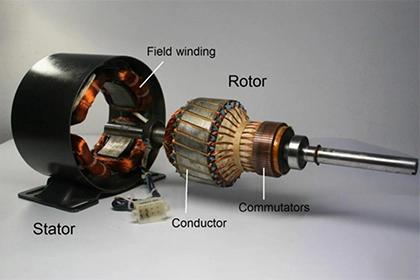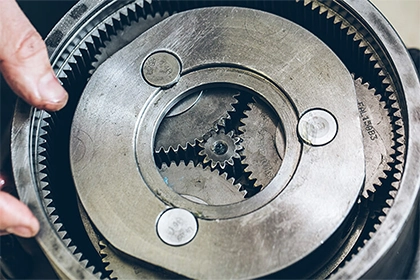
AC servo motor vibration failure analysis
Vibration failures of AC servo motors are usually caused by mechanical or electrical factors.
The AC servo system includes: servo drive, servo motor, and a feedback sensor. The analysis of vibration faults in AC servo motors mainly focuses on mechanical and electrical aspects.

Mechanical Aspect
-
Bearing
The bearing on the screw shaft bearing seat has excessive clearance after wear, or the bearing lacks grease, resulting in severe wear of the bearing rolling elements and cage, causing excessive load. Excessive clearance after bearing wear can cause coaxiality errors between the motor rotor center and the screw center, causing the mechanical system to jitter. Severe wear of the bearing rolling elements and cage can increase friction, leading to 'stalling'. 'Stalling', without causing 'overload alarm', due to excessive load, will increase the response time of the servo system and generate vibration.
-
Motor rotor unbalance
When there are defects in the dynamic balance of the motor rotor during manufacturing or it deteriorates after use, a vibration source similar to a "vibrating motor" will be generated.
-
Axis bending
The situation of bent shaft is similar to rotor unbalance, which not only generates vibration source but also produces coaxiality error between the motor rotor center and the screw center, causing jitter in the mechanical transmission system.
-
Coupling
Coupling manufacturing defects or wear after use can cause coaxiality errors between the two parts of the coupling, especially when using rigid couplings made of castings, which are more prone to vibration due to their poor manufacturing accuracy.
-
Parallelism of the guide rail
Poor parallelism of the guide rail during manufacturing can cause the servo system to fail to reach or stay at the specified position. In this case, the servo motor will continuously search for the position, causing continuous motor vibration.
-
Parallelism error between screw and guide rail plane
The parallelism error between the screw and the guide rail plane, as well as the parallelism error between the screw and the plane where the guide rail is located during installation, can cause vibration in the motor due to uneven load.
-
Screw bending
After the lead screw is bent, it will not only be subjected to axial thrust but also to varying radial forces. When the bending is large, the radial force is large; when the bending is small, the radial force is small. Similarly, this undesired radial force will also cause vibration in the mechanical transmission system.
Electrical aspects
The main reason for the electrical problems of the servo motor in communication is mainly due to the parameter adjustment of the servo drive.
-
Load inertia
The setting of load inertia is generally related to the size of the load. Setting a too-large load inertia parameter may cause vibration in the system. Typically, AC servo motors can automatically measure the load inertia of the system.
-
Speed Proportional Gain
The higher the set value, the higher the gain, and the greater the system stiffness. The parameter value is determined according to the specific servo drive model and load situation. In general, the larger the load inertia, the larger the set value. In the case where the system does not produce vibration, the set value should be as large as possible. However, the larger the gain, the smaller the deviation, and the easier it is to produce vibration.
-
Speed Integral Constant
Generally, in the absence of vibration generated by the system, the set value should be set as small as possible. The smaller the setting value, the faster the integral speed, and the stronger the system's resistance to deviation, that is, the greater the stiffness. However, if it is too small, it is easy to produce overshoot, causing the motor to vibrate.
-
Position Proportional Gain
The higher the set value, the higher the gain, and the greater the stiffness. Under the same frequency instruction pulse conditions, the smaller the position lag, but a value that is too large may cause motor vibration.
-
Acceleration feedback gain
When the motor does not rotate, a very small offset will be amplified by the proportional gain of the speed loop, and the speed feedback will generate a corresponding torque, causing the motor to oscillate back and forth.
According to on-site judgment
Knowing which aspects will lead to vibration faults in communication servo motors, narrowing down the fault range further, and locking down the cause of the fault is a difficult point in actual maintenance, requiring a comprehensive judgment based on specific on-site information.
-
The malfunction occurred after the new device was powered on and debugged.
The faults that occur during this time are the most complex, possibly due to mechanical manufacturing reasons or incorrect parameter adjustments. They need to be eliminated step by step, following the principle of eliminating simple reasons first and then complex ones. If the CNC system is equipped with two or more identical drives and AC servo motors, and one motor generates vibration, the simplest 'exchange method' can be used to exchange the servo drives of the two AC servo motors. This method can quickly determine whether the problem lies in the servo drive parameter settings.
-
The malfunction occurred after the equipment had been running for a long time.
This situation can rule out the problem of servo drive parameter settings because if the parameters were set incorrectly, the issue would have been reflected long ago.
-
The malfunction occurred just after the machine was turned on.
If the AC servo motor vibrates just after power is on, it can be determined that a mechanical obstruction occurred during the CNC system's automatic search for the machine tool origin, causing the motor to not reach the specified position or to repeatedly reach the specified position. In this case, it is generally a mechanical failure.
-
The malfunction occurred while the machine tool was processing the workpiece.
In this situation, the first thing to consider is vibration caused by increased load during processing, investigate the reasons surrounding the increased load.
-
The fault occurs continuously in a regular pattern or intermittently in an irregular pattern.
When the failure occurs continuously, it indicates that the cause of motor vibration has been present all along, while when it occurs intermittently and irregularly, it suggests that the cause of motor vibration may change from time to time. In this case, if the load does not change significantly, it can rule out the reasons related to the servo drive parameters settings.
The vibration failure of the AC servo motor is caused by various complex reasons. It is found from practical operation that the proportion of motor failures caused by mechanical faults or mechanical faults is relatively large. When troubleshooting such faults, it is necessary to understand the working principle of the AC servo system, know which reasons are prone to cause motor vibration failures and make comprehensive judgments based on the on-site situation to completely solve the vibration failure of the AC servo motor.



Leave a Comment